Art teachers and their cats are on the great list of art teacher stereotypes. This is a stereotype, true or not, that has been perpetuated over time. However, when you stop and consider it, there really is a long history of artists and their beloved cat companions that goes back to ancient Egypt. Some of these cat-loving artists even include big names like Matisse, Warhol, and Klimt.
Lauren Suveges is a middle school art teacher in Oregon. In an episode of the AOEU podcast The Art of SEL, she talks about how she made cats a part of her classroom management with her Bad Day Cat Day sculpture. When students are experiencing a particularly bad day, the whimsical sculpture takes up residence on their desk while they work. Now, her students believe she collects cats at home. What was she to do but lean into that assumption?
Like Lauren, let’s lean into the hilarity, beauty, and fun of cats with nine artists (for nine lives) who include cats in their work. The following artists can inspire whole class art explorations, a connection for the cat-obsessed student, or a featured artist for an artist of the month board.
1. Edie Harper
Edie Harper was a photographer and painter from Cincinnati, Ohio. Her mid-century prints and paintings depict cats in flat colors with simple shapes and repetition. Interestingly, her cats contrast the famed cardinals of her artist husband, Charley. Both artists use humor and puns in their artwork.

Artmaking Idea: Challenge students to use puns as inspiration to create cut paper cat images.
2. Louis Wain
Louis Wain was an English artist who drew anthropomorphic cats. Sketchbook in hand, he observed humans interacting in real life and then depicted their body language in the form of cats. His cats are shown drinking tea, participating in musical performances, or enjoying meals together. Later in life, his cat imagery took on the appearance of a kaleidoscope with fractals of bright color and symmetry.
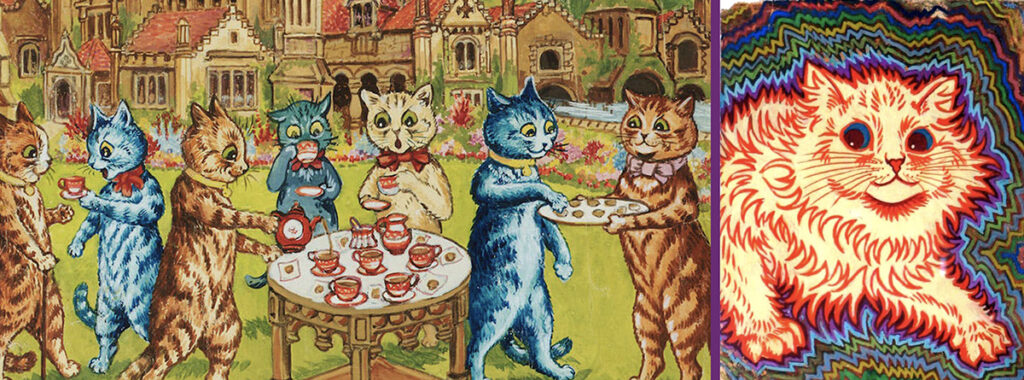
Artmaking Idea: Students reinterpret found images of people in action. Substitute cats (or the animal of their choice) in the place of the humans.
3. Heather Mattoon
Speaking of humanized cats, illustrator Heather Mattoon’s series Cats in Clothes features… cats in clothes. Realistic cat faces perch above stylish bodies in coats, scarves, and bowties. The clothes depict the particular cat’s personality. Heather’s Etsy page is full of humor; one descriptor reads, “Brewster is hiding a sharpie in his pocket. He likes to mark his territory.”
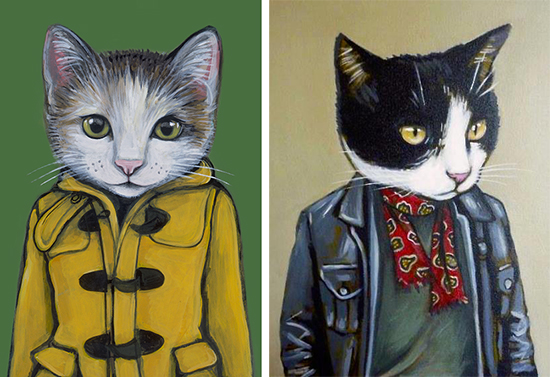
Artmaking Idea: Students collage images of cat faces onto prints of vintage paper doll bodies. Include found papers and mixed-media items to create a background fit for their furry personality.
4. Terry Runyan
Terry Runyan is an illustrator living in Kansas City with her two cat buddies, who inspire a lot of her work. Her watercolor and mixed-media illustrations feature cats with bright circular eyes, long tails, and simple textural lines. Terry is also in the business of inspiring others. Her Facebook group, Daily Creating, challenges members to create every day, often with playful prompts.
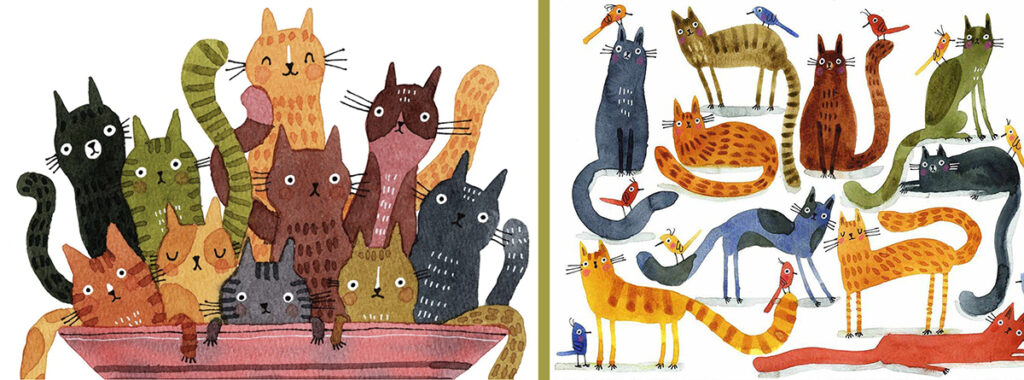
Artmaking Idea: Use watercolors and mixed-media materials to produce animals with stylized textures. Or become a member of the Daily Creating group and use the provided prompts to inspire student (and your own) artmaking.
5. Karen Obuhanych
Karen Obuhanych is another contemporary illustrator who finds joy in the playful and often sneaky nature of cats. This Hawaii-based artist is driven by “the simple element of happiness.” Her illustrations feature black cats doing what they do best—hiding in plants, playing with yarn, and of course, sleeping. And like Edie Harper, Karen appreciates a good cat-centered pun, which is on full display in her printable Valentine’s cards.
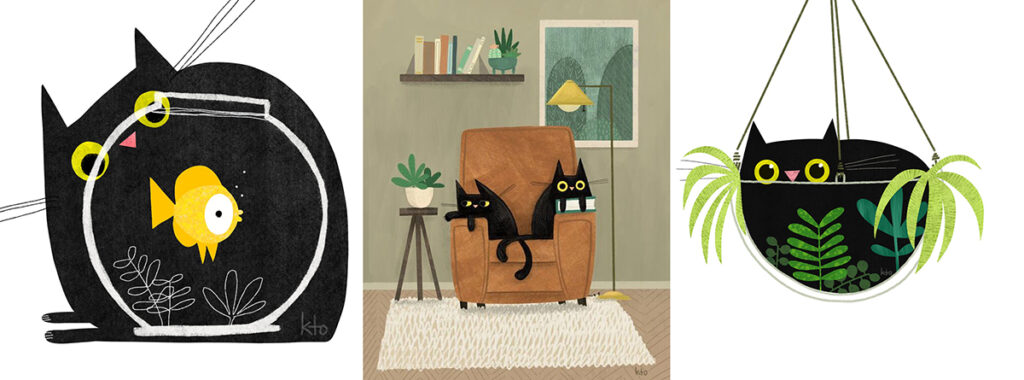
Artmaking Idea: Use simple shapes to create images of cats living their best lives, such as knocking over coffee cups, chasing mice, or sleeping. Compare and contrast Karen’s stylized black cats to Laurel Burch’s patterned cats.
6. Vanessa Stockard
Like Karen Obuhanych, Vanessa’s paintings focus on the personalities and misadventures of black cats. Kevin (a docile cat) and Satan (quite the opposite) find their way into paintings that pay homage to master artists. Mona Lisa’s coy smile is paired with a yellow-eyed Kevin in her arms. Vanessa uses a loose brushwork technique with thick, expressive strokes. This matches the often erratic actions of a cat attacking a pristine armchair.
Artmaking Idea: Students add cats to reproductions of famous masterworks, determining how the original figures will or will not interact with the new feline additions.
7. Tomi Ungerer and Ayla Suzan Yöndel
In 2011, Tomi (a French artist) and Ayla (a German architect) designed a kindergarten structure in the form of a cat. A mouth serves as a door and there are window eyes and a classroom within the belly. Students ride down the cat’s tail that functions as a slide to transport students from inside to the school’s backyard.

Artmaking Idea: Reimagine familiar architecture, like a house or a school, in the shape of a cat or other animal. Discuss the role of form and function in the students’ decision-making process.
8. Raymie Iadevaia
In his artist statement, Raymie shares, “like a cat brushing its head on people and places, I paint to get closer to the textures of the world.” Raymie’s paintings include cats composed of unexpected, dramatic colors. A focus on high contrast gives his cats an other-worldly appearance. He also applies layers of oil paint to produce canvases with rich texture.
Artmaking Idea: Students create their own richly textured paint by mixing collected pencil shavings into tempera paint before applying it to a paper or canvas.
9. Tony Mendoza
When this photographer first moved to New York City, rent was high, so a roommate made sense. The roommate’s cat, Ernie, became Tony’s muse as he documented the cat’s life every single day. Many of these images made their way into a published book, Ernie: A Photographer’s Memoir. The accompanying text is written in the voices of both Tony and Ernie.
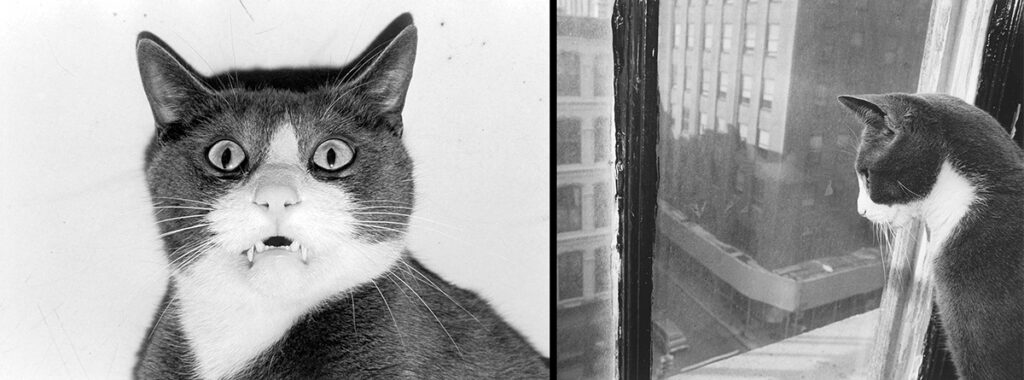
Artmaking Idea: Photograph a subject every day for a predetermined amount of time. Consider how the time of day, light, and energy of the subject changes.
Cats can serve as a means of inspiration for a multitude of creative possibilities and fun discussions. Apply any of the artmaking ideas shared here and adapt for any animal companion. Conversations or studio explorations that involve cats can also include a discussion about local animal shelters and the proper care and appreciation these furry friends need. Leaning into this particular art teacher stereotype might not be so bad. It is worth it when students engage in meaningful learning, laughter, and inspired artmaking.
Which of these artists speaks to you artistically, educationally, or personally?
Which of these artists immediately brings to mind a specific student? Share the artist’s work with that student.
What animal are you a super fan of and how can you bring your interest into the art room?
Magazine articles and podcasts are opinions of professional education contributors and do not necessarily represent the position of the Art of Education University (AOEU) or its academic offerings. Contributors use terms in the way they are most often talked about in the scope of their educational experiences.





